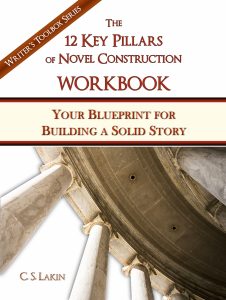4 Key Ways to Ramp Up Tension and Pacing in Your Fiction
This month we’ve been looking at pacing and tension, the fiction writer’s Fatal Flaw #7. This isn’t always easy for writers to assess in their scenes. How can you tell if your scene is dragging and there is little tension?
Our four editors explored some great ways to ramp up tension and pacing in novel scenes. To reiterate, here are some key points:
1) Inner and outer conflict. First, overall, you want to have your pages full to the brim with conflict. Meaningful conflict. Showing a character fussing for a full page about her lousy manicure isn’t all that meaningful.
Now, that situation could be the center of a really hilarious comedic moment, and if so, terrific. Humor—great humor—is so often overlooked, and it ramps up pacing and engages readers. But not all novels are chock-full of funny moments.
Conflict is tension. Meaningful conflict creates strong tension. Hemingway said, “Don’t mistake movement for action.” Just because you have a lot of things happening, plot-wise, doesn’t mean anything is really happening. You could have tons of exciting car chases and plane crashes and shoot-outs and the reader could be dozing off, nose planting into your book.
So, be sure to provide meaningful inner and outer conflict everywhere you can. The more you can complicate your characters’ lives, the more potential tension. Show your characters struggling inside and out. But this topic always swings me back around to the key factor in creating tension.
2) Engaging characters. If I’ve said this once, I’ve said it a thousand times: if readers don’t care about your characters, care what happens to them, they are not going to feel that tension. We want our readers tense. Worried, concerned, glued to the page, anxious to know what happens next. They aren’t going to feel that tension unless you do the hard preliminary work of developing and then bringing to life from the get-go those empathetic, unique, compelling characters.
Yes, you may have a great plot. An exciting, riveting, original plot. But if your characters are boring, uninteresting, mundane, annoying, lacking passion or skills or interest in something, anything, all the great plot twists in the world won’t create tension.
If you can take home one key bit of info about tension and pacing, make it this one.
3) Don’t bog your scenes down with a lot of boring stuff. What’s boring? Anything that isn’t interesting. I shouldn’t have to spell this out, right? When you read a novel and you find yourself drifting off, thinking about what to make for dinner, skimming over pages that you later realize you might have read but can’t remember, you know you just hit a boring patch.
This can be applied to macro and micro issues. You don’t want boring scenes—characters sitting around in dull, uninteresting settings (some of you are familiar with my rant about too many scenes in Starbuck’s or restaurants, with characters just talking and drinking coffee).
Every scene needs to have a clear, important purpose in advancing and/or complicating your plot. Making it harder for your protagonist to reach her goal. Usually the reason so many scenes in first novels lack tension and pacing is there’s nothing happening. We explored all this in February as we looked at Fatal Flaw #2: Nothin’ Happenin’.
Go through your WIP (work in progress). Ditch every scene in which nothing is happening. Or rework so that something significant is happening. I can’t emphasize enough how important that scene outline is. That’s why I created this scene checklist and scene structure template. Think about using these for every scene.
I can guarantee you: if you make sure every scene is important to your story and serves to advance the plot, you will find your pacing and tension ramping up.
On the micro level, look at your writing. Most of the novels I edit and critique are stuffed with extraneous words that drag. Pretend that each word has some intrinsic weight, and that your readers are carrying your scenes up a steep hill. The heavier the sack of words they are carrying, the harder the struggle to make it to the peak.
If I were climbing that hill and the sack was too heavy, I’d stop, sit, and dump the contents out on the ground. Then pick through all those words and toss out as many as I could that I really don’t need. Often you can throw out four in exchange for one good word. Make every word count. Your reader will climb to the climax of your story with a lighter, happier step.
Tension and Pacing are one of the foundational pillars of novel construction. If you need to know more, read the posts from last year’s course on tension. They’re intense. And if you buy and use The 12 Key Pillars of Novel Construction workbook, you will be challenged to create all the tension you need for your novel to sizzle.
4) Spend time developing a trademark writing style. Maybe you hadn’t considered this could affect pacing and tension, but it does. This ties back in with “boring.” If you use unimaginative words, phrases, descriptions, narrative, you have to work all that much harder to keep your reader’s interest. Your plot, characters, and other novel components will have to carry the entire weight of the tension and pacing.
In contrast, you can often have very little happening in the way of plot. And yes, I’ll go so far as to say, you could even have that boring scene in that boring restaurant turn into a riveting, page-turning tense experience for your reader if your writing is spectacular. What I mean by that is your prose is beautiful; your word choice is fresh and surprising; your concepts and abstracts are imaginative and wholly new; and your metaphors, motifs, symbolism, and similes are moving and thought-provoking.
No, it’s not likely you are going to wow your reader with every line, but why not aim for every page to convey a firm grasp of creative use of language. Make it your aim to be a fine wordsmith, to craft beautiful sentences the way a sculptor or painter handles marble or paint. The blank page is your canvas, and the words you write and subsequently publish showcase your talent and creativity to the world. Don’t paint boring word pictures when you could do oh so much more than just slap words onto the page without careful thought.
One last comment about pacing. Having a strong pace throughout your book doesn’t mean keeping everything moving a light speed. Don’t confuse pacing with speed. You need to have slow, reflective moments with your characters. Novels are a cycle of action-reaction-action-reaction. Things happen, characters react, process, make decisions (act), then more things happen.
You might think in those reflective moments that the pace has slowed down. The car chase is over, and now the hero is sitting in a chair in the hospital looking at the woman he loves, who is in a coma. Sure, the action has slowed down, Remember Hemingway: movement doesn’t mean action. Similarly, lack of movement doesn’t mean lack of action. A poignant, heavy emotional scene in which there is little action can be as tense or even much tenser than that high-speed car chase. Why? Because you’ve gotten your readers emotionally invested in your characters. Make sense?
You probably didn’t imagine there was so much to pacing and tension in fiction. I hope this month’s exploration helps you spot those flaws in your fiction (and in the novels and short stories you read) and remedy them so that your scenes sizzle with tension and your readers keep turning pages, eager to know what happens next.
Your turn:
What makes you tense when reading a novel? What slows the pacing for you? Any thoughts on the best ways to create tension in your scenes? Want to share something you did to ramp up the pacing and tension in a boring scene you had?









Excellent tips – thank you! Especially appreciate “don’t confuse pacing with speed.” There’s no tension in one fast ball after another flying toward the batter if we don’t get see what happens after each pitch!
Great tips. Sharing now!
This article fits in with this month’s “Writing Great Stories.” Thank you for allowing me to present your material. Good timing. Love your informative site, and your great instructional books. I admire your talent.
Thanks so much for sharing. I click the Twitter Icon and I hope it will reach people to check out your site. I’m not sure what retweeting is or how to do it so I hope what I did was okay.